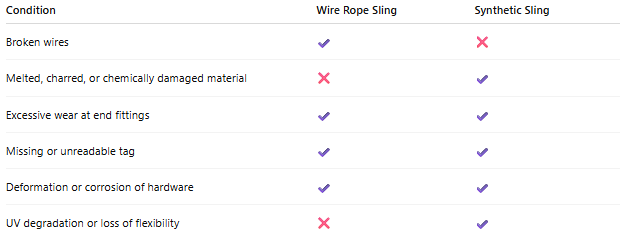Rigging Safety: What You Need to Know About Wire Rope and Synthetic Slings
In construction, manufacturing, and heavy industry, rigging equipment is critical to safe lifting operations. Wire rope and synthetic slings are among the most common lifting devices, and each comes with unique inspection requirements, failure indicators, and service limitations. This guide will walk through the key safety principles of rigging, helping you avoid dangerous lifts and stay compliant with OSHA and industry standards.
Anatomy of Wire Rope and Synthetic Slings
Wire Rope Slings are constructed from individual steel wires twisted into strands, which are then wound into a helical structure around a core (either fiber or steel). The design allows for strength, flexibility, and resistance to abrasion. End fittings such as thimbles, hooks, or swaged sleeves are often added to form lifting loops.
Synthetic Slings, such as web slings or round slings, are typically made from nylon or polyester. Web slings are flat and wide, while round slings are tubular with internal fibers wrapped continuously. Synthetic slings are known for their lightweight, flexibility, and minimal damage to loads.
Inspection Frequency Requirements
OSHA (29 CFR 1910.184 and 1926.251) and ASME (B30 series, especially B30.9) outline inspection requirements for rigging equipment. In general, three types of inspections are required:
Initial Inspection – Performed by a qualified person before the first use of a sling.
Frequent Inspection – Conducted each day before use or during use if conditions change. This is a visual check by the sling user.
Periodic Inspection – Performed at least annually by a designated person, with frequency increasing based on usage, severity of service conditions, and sling type. For example:
Severe service: every 1–3 months
Normal service: annually
Wire rope may need quarterly inspections in heavy-use environments
All inspections must be documented when periodic.
What to Look for During Inspections
Wire Rope Sling Inspection Criteria:
Broken wires: 10 randomly distributed wires in one rope lay, or 5 in one strand.
Kinking, birdcaging, or crushing
Corrosion or pitting, especially in end connections
Core failure (e.g., wire rope feels “flat” or irregular)
Deformed end fittings or cracked attachments
Heat damage or weld splatter
Synthetic Sling Inspection Criteria:
Cuts, snags, punctures, or broken stitching
Acid or caustic burns, melting, or charring
UV damage (faded colors, brittle texture)
Knots or improperly repaired areas
Distorted or cracked fittings
Illegible or missing identification tags
When to Remove Slings from Service
OSHA requires immediate removal from service if any inspection reveals a defect. ASME B30.9 goes further by listing detailed removal criteria for each type of sling.
Common Removal Triggers:
For both types, modifications or repairs must not be made by field workers unless they are authorized by the manufacturer or a qualified repair facility.
Qualifications for Inspectors
OSHA does not mandate specific certifications for sling inspectors but states that periodic inspections must be performed by a competent or designated person—defined as someone who is “capable of identifying existing and predictable hazards... and who has authorization to take corrective measures.”
However, ASME and industry best practices recommend training and/or certification. Common options include:
Qualified Rigger Level I or II (NCCCO or equivalent)
Rigging Inspector Certification (from accredited bodies like Crosby or ITI)
Employer-designated Competent Person training
In high-risk operations, documented training and practical experience are essential for legal defensibility and safety assurance.
Final Thoughts
Rigging safety isn’t just about strong equipment—it’s about consistent inspections, trained eyes, and knowing when to pull a sling from service. Whether you're lifting a few hundred pounds or multiple tons, the failure of a sling can be catastrophic. By aligning your program with OSHA regulations and the more detailed ASME B30.9 guidance, you ensure both compliance and peace of mind.
If your team uses slings, ask yourself:
Are your inspections documented and frequent enough?
Do your workers know what to look for?
Is someone trained and trusted to make the call when something looks wrong?
Rigging failures are preventable. Safety starts before the lift ever begins.

